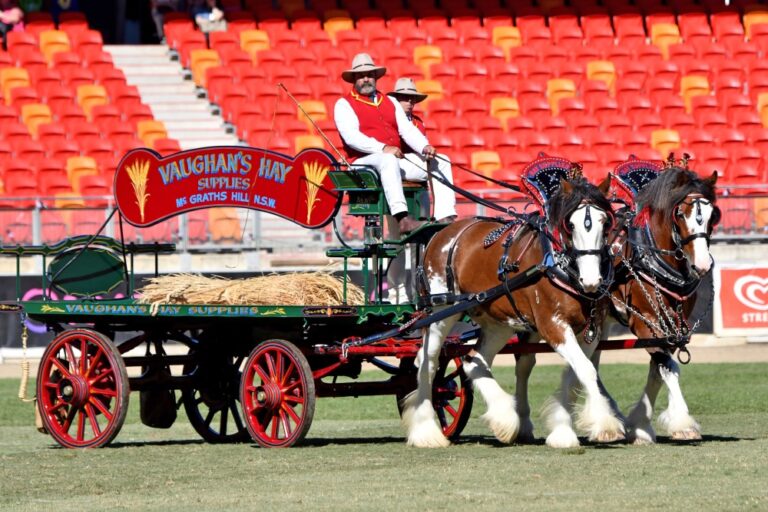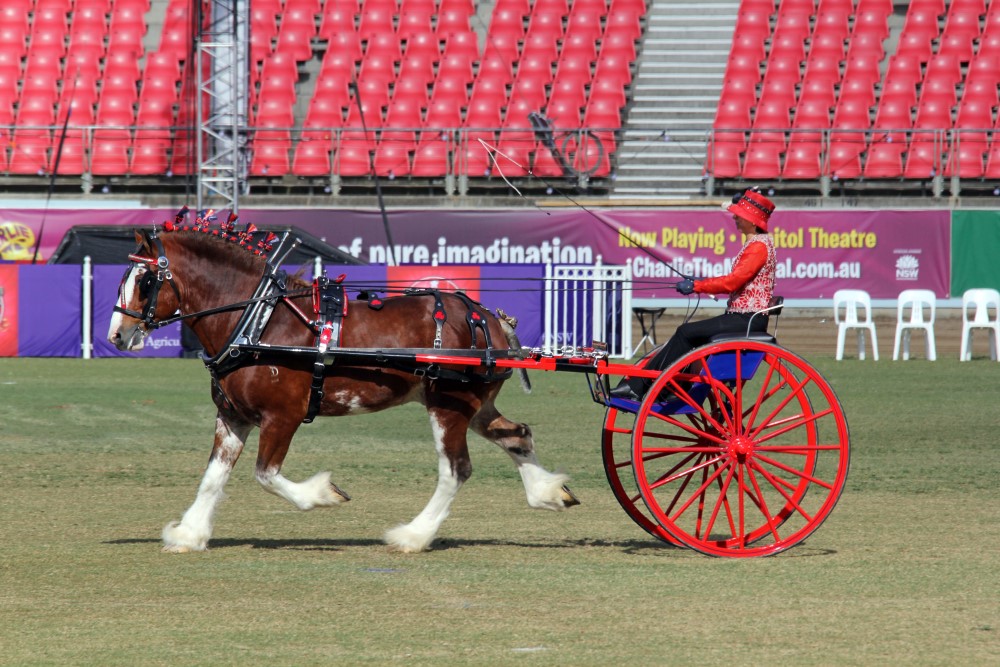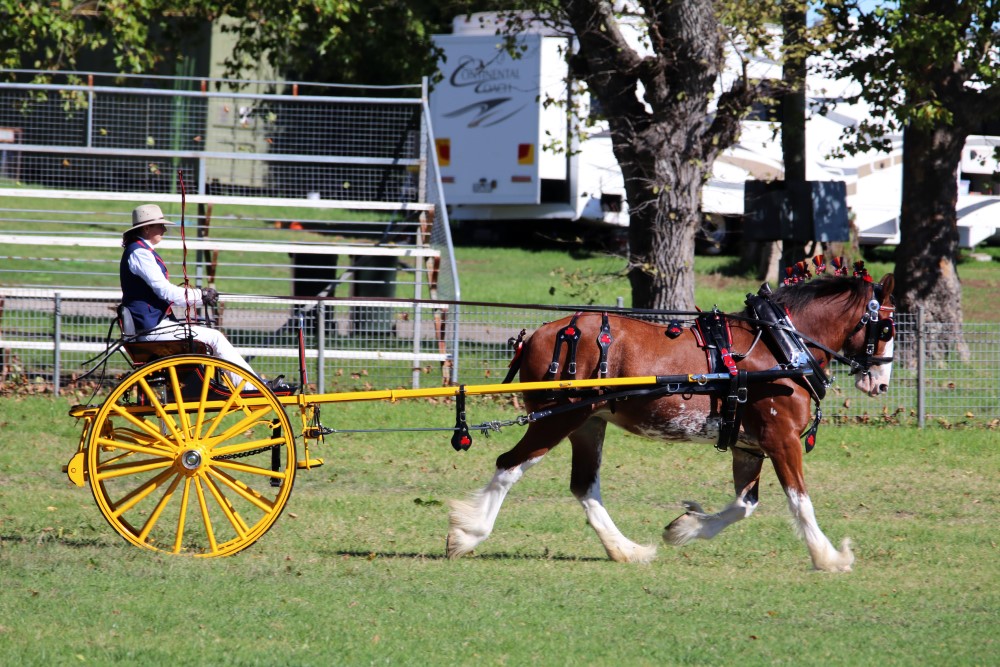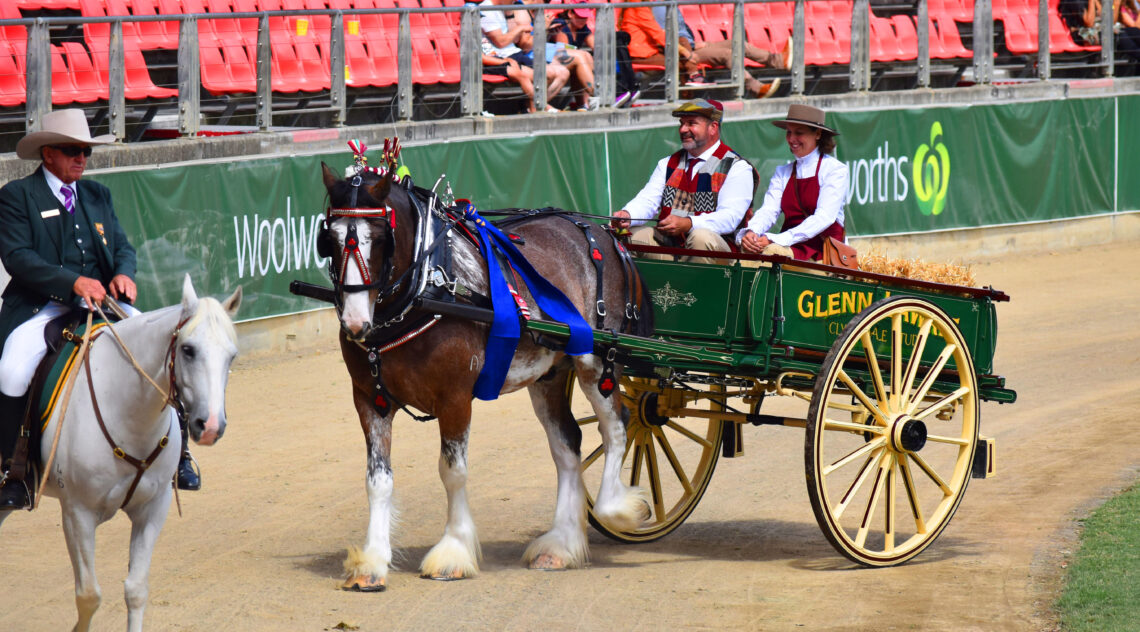Liz Lewis’s fascination with horses goes back as far as she can remember, and her passion didn’t wane as she grew up. When she was 15-years-old, her parents presented her with her first horse, and eventing became Liz’s discipline of choice. She trained and competed in the sport up until around five years ago, when, I guess it’s fair to say, another love kicked in.
Liz’s husband Erin has an extensive background in harness: from running a horse and carriage business in Sydney’s historic Rocks area, through to movie work and horse stunts. I started off holding the reins for Erin and helping out in general when he worked his horses in harness, Liz tells me, but the passion really ignited when we went on a road trip in February 2015 to look at some Clydesdales that were up for sale. That’s when he bought Sunny for me, and Sunny has turned out to be my heart horse.
You may be surprised to learn that in a global context, the Clydesdale breed is considered vulnerable. As it happens, Australia is one of the world’s most prolific producers of Clydesdales, with studs here breeding around 300 registered foals in 2020 alone.
While the Clydesdale is popular under saddle, they are absolutely majestic in harness – and interestingly, there are a significant number of female drivers who have taken up the reins. Liz has a theory about that: I think women like the temperament and trainability of these enormous horses. They really are an absolute pleasure to work with, and to be around.
And she should know. Liz and Erin own Elemer Clydesdales, a boutique stud in Bargo on the outskirts of the NSW’s Southern Highlands. We stand one stallion at stud, Jeanal Summer Solstice (Sunny), and have four broodmares, two purebred, and two part-bred, she says. We produce up to four foals a year, so we’re not inundated with progeny and therefore have the time to train, show, and break them in before they’re ready for sale. It gives us peace of mind to know that our horses have had the best possible start in life before they go to their new homes.
And the couple’s training philosophy is commendable: There’s good handling of horses, and then there can be bad, Liz comments. Training begins at birth. Every time we’re around the foals they’re always learning a lesson. From the basics – teaching them to lead, tie up, and hobble – through to breaking them in. All these lessons eventually come together over a number of years to create a confident, happy, respectful, safe and educated horse.
But back to harness, and this is a learning curve all on its own. Liz tells me that there are three harness categories: trade, agricultural and non-traditional.
Trade, as the name suggests, includes turnout classes for the uniquely Australian harness and vehicles traditionally used prior to the 1960s by the likes of milkmen, bakers, breweries, and produce merchants.
Show judges score on a points system: 50 for the horse – its type, conformation, and suitability for the trade it’s being shown in – and for workout, including movement, action, obedience, and ability to perform certain manoeuvres such as fanning (turning the vehicle on itself), and reversing, necessary for backing a vehicle into a loading bay.
A further 30 points are allocated for the vehicle itself: Judges assess its authenticity, the paint and line work, and whether it’s set up with a correct load, and with the appropriate tools or equipment, Liz explains. Then a further 10 points are awarded for clean, safe harness, whether it fits properly, and whether the horse is correctly harnessed. Decorations should be in colours appropriate for the business or trade, and these days are often matched to the vehicle’s signage. The bottom line is that every single element must suit the trade being depicted.
The last 10 points are for general appearance, including how the driver and passengers are dressed, how the horses are presented, and the overall look of the turnout.
Agricultural classes are for exhibiting farm implements and equipment traditionally used for growing and harvesting crops, road grading and building dams.
Lastly, the non-traditional harness classes primarily give owners the chance to show off their horse, its movement and action. This usually involves a lightweight vehicle, which is easier for the horse to pull, giving the driver more opportunity to show their horse to the best possible advantage, Liz says, and these days, competitors are using harness made of materials such as BioThane, which is very lightweight compared to leather, and that helps with the horse’s ability to step and move.
Preparing a Clydesdale for a show is, as you may have suspected, a bit of an art form. Traditionally Clydesdales are shown with a mane roll, which is wool braided through their mane, and standards , a decoration that stands upright and enhances the neck, Liz tells me. The colours used for both the mane and tail decorations were once blue and white, the colours of the Scottish flag, but exhibitors can now choose whichever colours they like.
In the old days tails were docked, a practice that’s thankfully long gone. However, during the show season, Clydesdale’s docks are often shaved, with the remaining hair braided upwards into a bun. That’s done so the judges can view the horse’s hocks and action clearly, and check for unsoundness. It’s also for the horse’s safety. Long tails can easily become caught in equipment, causing injury and a great deal of unnecessary pain.
However, Liz has become aware of some misunderstanding surrounding this practice: People think the short tails are cruel, but I can assure you that exhibitors love their horses and use rugs and repellents to protect their equine friends from insects and flies. And for their added comfort, horses are often stabled during show season. When the season is over, their tails are left to grow long again.
A Clydesdale’s feathers are one of their most recognisable features and months of preparation go into ensuring that before entering the show ring, they’re as clean, white, soft and silky as they possibly can be.
Also requiring considerable care is the harness, which is polished and cleaned regularly to prevent chrome fittings from tarnishing maximum sparkle in the ring is the goal. Vehicles need their fair share of TLC too: wheels are maintained so they roll smoothly, and the cart is cleaned regularly to help prevent paint peeling, and housed to avoid heat or water damage.
I ask Liz whether there any special considerations regarding the driver’s clothing: Most definitely! We have an entire wardrobe of various outfits and uniforms to suit the various classes. For a non-traditional harness class, I like to dress in something feminine and sparkly, with a pretty, broad brimmed hat. For a traditional trade harness class we ll either wear a uniform, or a felt Akubra hat, moleskin pants and leather boots, whatever best suits the business or trade we’re portraying. We also have hand-sewn woollen patchwork vests and peaked caps with leather covered buttons. They’re for some of the traditional classes where the driver would be delivering goods to market, so we wear outfits appropriate to the task and era.
And if you thought that level of detail was pretty amazing, there’s more! Most trade harness carriages are fitted with lamps, so does the lamp look as if it’s in use? Is there an original candle inside? Has the wick been burnt and the wax melted? Do you have wax matches of a type that suit the period? Extra points are awarded for details like these, Liz explains.
There are other judge-pleasing details too, such as milk in the milk cart vats, and bread aboard the bread cart. And you should consider a docket book and pencil, because pre-smart phone, that’s how delivery drivers recorded their orders. One final delightful touch? The driver must carry a traditional leather moneybag, preferably complete with coins and notes of the era.
I don’t know about you, but to me, this all sounds like a lot of fun. It’s also reminiscent of a by-gone time, when the flow of life was not quite so frantic and that’s something that really is very appealing.






